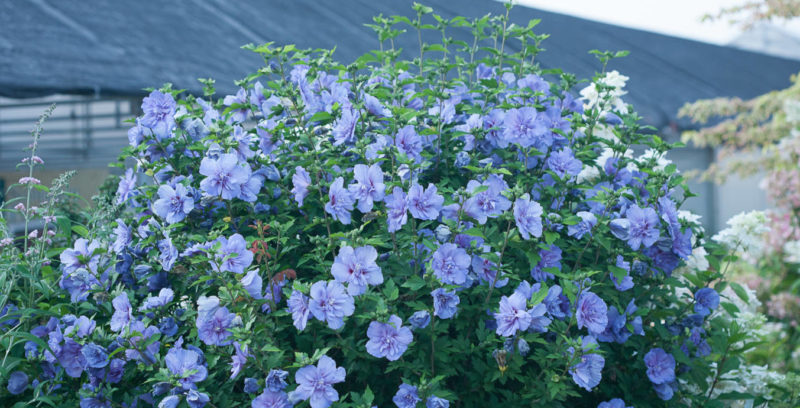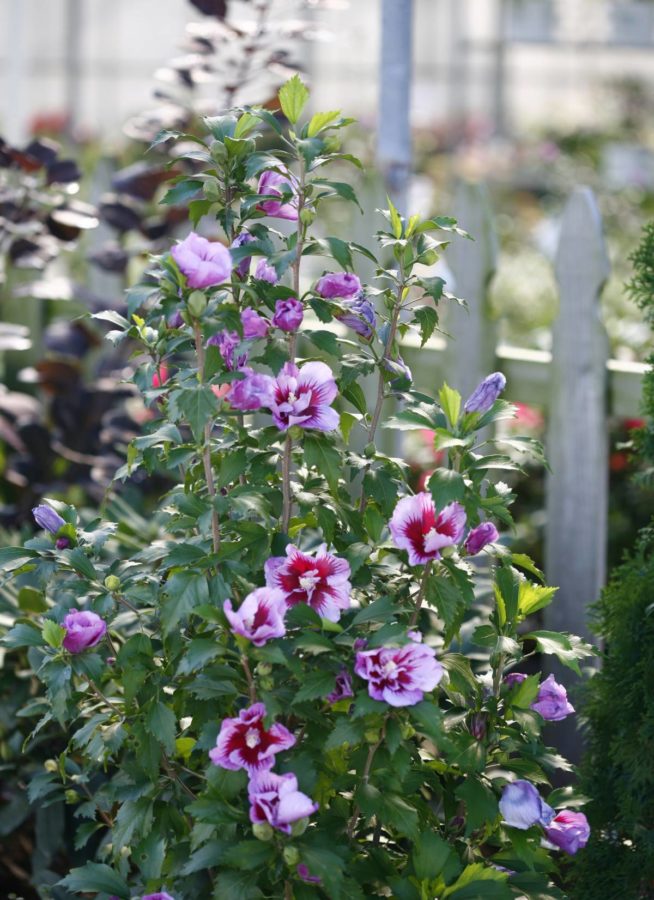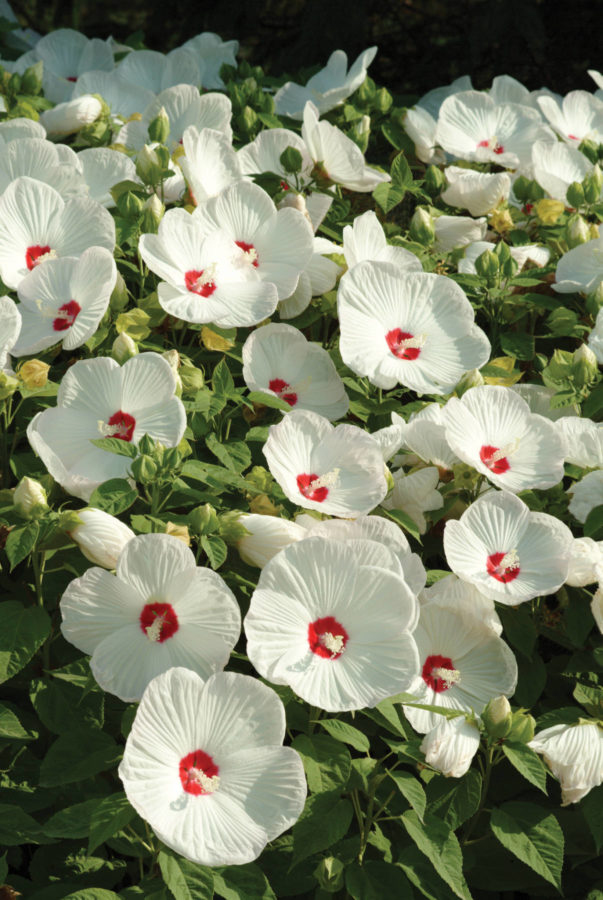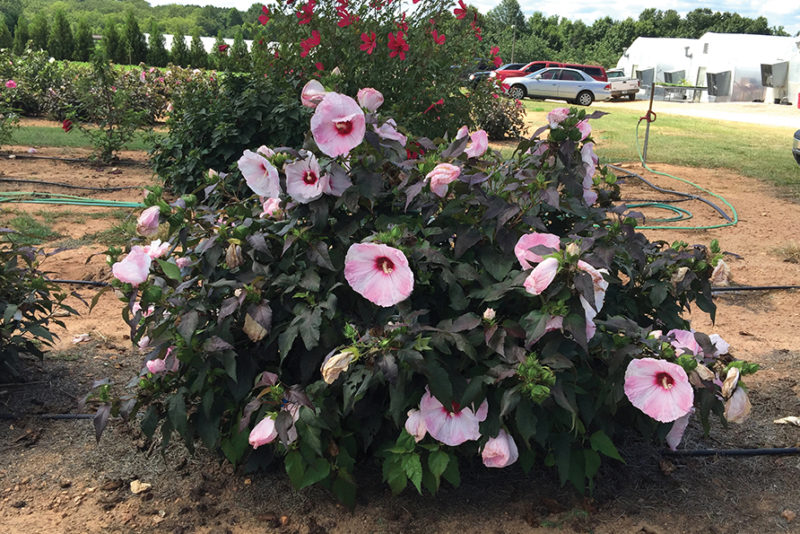
Pretty & Powerful: Hardy Hibiscus
In January and February, we celebrated sunflower and monarda. In its shrub category, the National Garden Bureau has designated 2021 as “Year of the Hardy Hibiscus.” We chatted with our friends at PanAmerican Seed, Star Roses and Plants, and Spring Meadow Nursery to discuss what’s trending in the category and how growers can capitalize.
Jasmina Dolce, GPN: The National Garden Bureau has declared 2021 the “Year of the Hardy Hibiscus.” Each year, the organization selects plant categories that are trending and reflect a need in the marketplace. Why do you think hardy hibiscus was chosen for 2021?
Jerry Gorchels, regional account manager, PanAmerican Seed: More consumers are interested in a tropical look for their garden, but of course not everyone is in a tropical climate. So these hardy, tropical-looking varieties have a lot of appeal. They put on quite a remarkable show when they’re in full bloom.
Natalie Carmolli, public relations specialist, Spring Meadow Nursery: I think hibiscus in general — whether it’s hardy, shrub or tropical — are a showpiece in any garden or landscape application. They are easy to maintain and it’s really quite thrilling to see their enormous, vibrant flowers opening in mid-summer. Plus, they support the pollinator population — you haven’t seen anything until you’ve seen a hummingbird battle over them!
Kristen Pullen, woody ornamental product manager, Star Roses and Plants: Hardy hibiscus are very versatile plants due to their wide hardiness range. Not only that, but they produce beautiful flowers with a tropical-like appearance. During a time when an unprecedented number of new gardeners are finding the joy in plants, highlighting a plant that needs little care to produce big results is a great idea.
GPN: What are your personal favorite attributes of hardy hibiscus? Do you have any favorite varieties?
Kristen Pullen: I enjoy that hardy hibiscus are easy to grow and that their flowers are so vibrant. Not only that, but their flowers are huge! My favorites are the Head Over Heels hibiscus series. In addition to large, bright flowers they also have deep burgundy foliage, which makes the flower colors pop even more.
Jerry Gorchels: I’m attracted to anything red and white — I love the impact of contrasting colors! The size of the blooms of ‘Luna White’ from PanAmerican Seed has the red eye, which I think is really striking. Plus Luna is hardy in Zones 5a to 9b.
Natalie Carmolli: Hardy hibiscus are kind of miraculous to me in that, at least here in Michigan, they die completely back to the ground and then don’t emerge until later in the summer. Honestly, with spring coming up all around, you almost forget they are there. But when they emerge? Get ready for a show. They leap up quickly like they’re saying “Hey, remember me? You think those spring flowers are pretty? Hold my beer.”
My favorite hardy hibiscus is ‘Summerific Holy Grail’. The deep purple, almost black foliage is the perfect backdrop for its huge, burgundy-colored flowers. And once they start flowering, it’s like an explosion, with weeks of flowers covering the plant. People walking by my house stop dead in their tracks to look at it when it’s in full bloom. Pair that with something like the yellow and chartreuse foliage of Brass Buckle Japanese holly, or Soft Serve Gold false cypress, and you may have to start instituting some crowd control!

Although not a hardy hibiscus, there is a low seed set Rose of Sharon I have my eye on. ‘Blue Chiffon’ H. syriacus is just stunning. If you have the sunny space to add this plant as a specimen in your garden (it can get up to 12 feet tall), it will reward you in the summer with hundreds of true-blue, double flowers.
GPN: What has been your organization’s role in the development, marketing and sale or hibiscus?
Kristen Pullen: At Star Roses and Plants, we’ve been working closely with hibiscus breeders since 2015. Our first hibiscus introductions to the market were ‘Head Over Heels Blush’ and ‘Head Over Heels Passion’ in 2018. We’ve been actively selecting new colors to add to the series and now have a total of five Head Over Heels hibiscus varieties on the market. As with all our genetics, we extensively trial before bringing a plant to market to be sure that these hibiscus improve upon what people already love about the genus.
Jerry Gorchels: PanAmerican Seed breeder Ellen Leue started the Luna hibiscus line in the late 1980s and early 1990s. Disco was the series to beat at the time, and we bred a line that had better branching and uniformity for habit and flowering.
Natalie Carmolli: At Spring Meadow, we grow shrub hibiscus, also called Rose of Sharon — most frequently referring to the species Hibiscus syriacus. Although they’re not technically what we think of when we hear hardy hibiscus, we are thrilled to be considered alongside these beautiful species in the National Garden Bureau’s celebration of hibiscus. Don’t take this to mean H. syriacus isn’t hardy, though! They thrive in a wide hardiness range, USDA Zone 5 to 9.
Shrub hibiscus differ from hardy hibiscus in that Rose of Sharon has a woody habit and blooms on the same structure each year, rather than dying back to the ground. They also tend to be a lot larger in size, with some varieties, like the beautiful seedless specimen ‘Azurri Blue Satin’ Rose of Sharon, reaching heights of 8 to 12 feet.
We have been breeding H. syriacus for larger flowers in unique colors, and low seed set, like Chiffon and Satin series, and also for more useful habits like the dwarf Lil’ Kim series and the columnar Pillar series. We actually just introduced a new series of Rose of Sharon called Paraplu, and my favorite is ‘Paraplu Pink Ink’. Its flowers have bright magenta rays bursting from the center over soft pink petals. It’s really quite stunning.
GPN: What changes and innovations have you seen over the years within the hardy hibiscus category?

Kristen Pullen: The main improvement I’ve seen has been habit. Some of the older varieties can get very large over the years — up to 7 feet tall, in some cases. Many of the newer varieties offer more compact options that are easier to take care of for growers and consumers. The other trend has been introductions with burgundy foliage to add another layer of color interest to the plants.
Natalie Carmolli: Breeding goals for Rose of Sharon are essentially the same as they are with all of our varieties. We want our new cultivars to be more beautiful and require less maintenance. We are looking for cultivars that will fill gaps in the market. So, if a 12-foot Rose of Sharon is a difficult sell, we have the 3- to 4-foot Pollypetite cultivar; if people are worried about reseeding, we have seedless/low seed set cultivars. And we’re looking for new flower colors, we have introduced ‘Paraplu Rouge’, which represents one of the reddest flowers we’ve seen in Rose of Sharon.
Jerry Gorchels: Today the Luna series is a leader in the perennial market. They are first-year flowering and a staple for the summer perennial benches.
GPN: Why do you think hardy hibiscus is growing in popularity at the consumer level?
Jerry Gorchels: Consumers are demanding a more tropical look in the garden, especially now as it’s more difficult to travel for a tropical vacation. They can now enjoy the “look” at home instead.
Natalie Carmolli: I think consumers are becoming more savvy gardeners. And with that, they feel more encouraged to make bold choices. They are learning how to create season-long interest in their gardens and are willing to wait for mid-summer show. But they also are leading busy lives, and they don’t have time to tend to high-maintenance plants. Nothing quite ticks all those boxes more than hardy hibiscus.
Kristen Pullen: Hardy hibiscus really do check all the boxes when it comes to what a typical consumer wants in a plant: low maintenance, long bloom window, deer resistant, attracts pollinators, and hardy for Zones 4 to 9. They’re also native to North America, which is a great attribute for our local pollinators.
GPN: Does hardy hibiscus present any challenges for growers?
Kristen Pullen: In the southern United States, sawfly can become a problem. The larvae have been known to completely defoliate plants. Newer breeding has been developing solutions for this problem.
Jerry Gorchels: Heat and long days are required for this crop. Growers will offer them for late-June and July sales.
GPN: How can growers capitalize on the hibiscus category?
Jerry Gorchels: Offer hibiscus in a couple of sizes to suit consumers’ different pocket books — 1 gallon, 2 gallon and a large patio planter ready to go. And sell them with a nice image of the bloom on a large tag to show the potential!

Kristen Pullen: Pick varieties that require minimum input on the grower level in terms of trims, spraying and residency time. Newer varieties have better branching and improved insect resistance. Star Roses and Plants offers a unique opportunity for growers with our Head Over Heels hibiscus in that they can be grown either in black pots or in our Bloomables branded program. In this way, growers can service both their landscape customers with black pot items and their retail customers with premium branded product all through the same great genetics.
Natalie Carmolli: I think growers can capitalize on this trend by carrying all species of hibiscus. Although it’s the year of the hardy hibiscus, our ongoing development of shrub hibiscus makes them a very versatile choice for home gardeners and one that I think stands up nicely to other species.
GPN: Is there anything in the hibiscus pipeline that you can share with us?
Kristen Pullen: Be on the lookout for new flower types like swirls and pinwheel blends of colors on the same bloom. As breeding continues, we’re always looking for solutions to grower challenges, such as sawfly.
Natalie Carmolli: Our hibiscus program continues to evaluate advanced selections from our internal and external breeders. The success of our current offerings has strengthened our commitment to this category. Based on the dramatic improvement of hibiscus over the past 20 years, we cannot wait to see what magic our breeders create!
Jasmina Dolce is managing editor of GPN magazine. She can be reached at jdolce@greatamericanpublish.com.


 Video Library
Video Library 




















